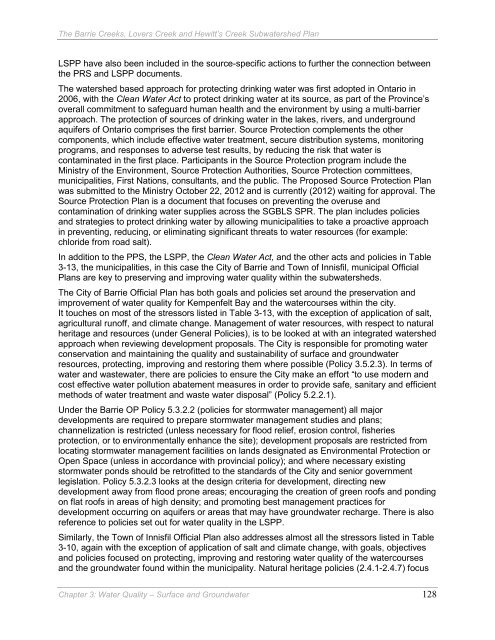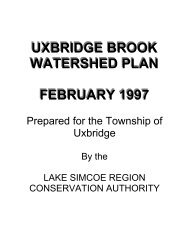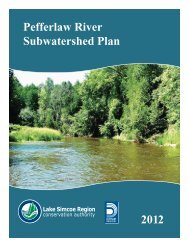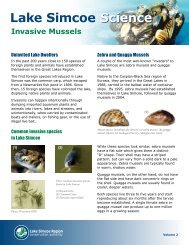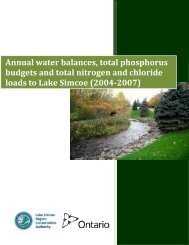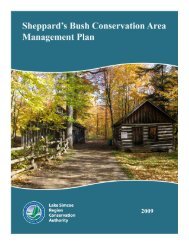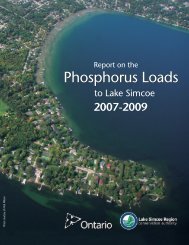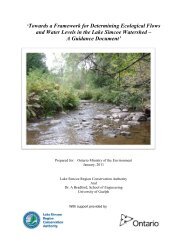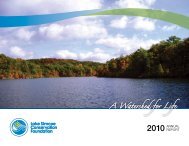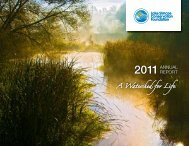Barrie Creeks, Lovers Creek, and Hewitt's Creek Subwatershed Plan
Barrie Creeks, Lovers Creek, and Hewitt's Creek Subwatershed Plan
Barrie Creeks, Lovers Creek, and Hewitt's Creek Subwatershed Plan
Create successful ePaper yourself
Turn your PDF publications into a flip-book with our unique Google optimized e-Paper software.
The <strong>Barrie</strong> <strong><strong>Creek</strong>s</strong>, <strong>Lovers</strong> <strong>Creek</strong> <strong>and</strong> Hewitt’s <strong>Creek</strong> <strong>Subwatershed</strong> <strong>Plan</strong><br />
LSPP have also been included in the source-specific actions to further the connection between<br />
the PRS <strong>and</strong> LSPP documents.<br />
The watershed based approach for protecting drinking water was first adopted in Ontario in<br />
2006, with the Clean Water Act to protect drinking water at its source, as part of the Province’s<br />
overall commitment to safeguard human health <strong>and</strong> the environment by using a multi-barrier<br />
approach. The protection of sources of drinking water in the lakes, rivers, <strong>and</strong> underground<br />
aquifers of Ontario comprises the first barrier. Source Protection complements the other<br />
components, which include effective water treatment, secure distribution systems, monitoring<br />
programs, <strong>and</strong> responses to adverse test results, by reducing the risk that water is<br />
contaminated in the first place. Participants in the Source Protection program include the<br />
Ministry of the Environment, Source Protection Authorities, Source Protection committees,<br />
municipalities, First Nations, consultants, <strong>and</strong> the public. The Proposed Source Protection <strong>Plan</strong><br />
was submitted to the Ministry October 22, 2012 <strong>and</strong> is currently (2012) waiting for approval. The<br />
Source Protection <strong>Plan</strong> is a document that focuses on preventing the overuse <strong>and</strong><br />
contamination of drinking water supplies across the SGBLS SPR. The plan includes policies<br />
<strong>and</strong> strategies to protect drinking water by allowing municipalities to take a proactive approach<br />
in preventing, reducing, or eliminating significant threats to water resources (for example:<br />
chloride from road salt).<br />
In addition to the PPS, the LSPP, the Clean Water Act, <strong>and</strong> the other acts <strong>and</strong> policies in Table<br />
3-13, the municipalities, in this case the City of <strong>Barrie</strong> <strong>and</strong> Town of Innisfil, municipal Official<br />
<strong>Plan</strong>s are key to preserving <strong>and</strong> improving water quality within the subwatersheds.<br />
The City of <strong>Barrie</strong> Official <strong>Plan</strong> has both goals <strong>and</strong> policies set around the preservation <strong>and</strong><br />
improvement of water quality for Kempenfelt Bay <strong>and</strong> the watercourses within the city.<br />
It touches on most of the stressors listed in Table 3-13, with the exception of application of salt,<br />
agricultural runoff, <strong>and</strong> climate change. Management of water resources, with respect to natural<br />
heritage <strong>and</strong> resources (under General Policies), is to be looked at with an integrated watershed<br />
approach when reviewing development proposals. The City is responsible for promoting water<br />
conservation <strong>and</strong> maintaining the quality <strong>and</strong> sustainability of surface <strong>and</strong> groundwater<br />
resources, protecting, improving <strong>and</strong> restoring them where possible (Policy 3.5.2.3). In terms of<br />
water <strong>and</strong> wastewater, there are policies to ensure the City make an effort “to use modern <strong>and</strong><br />
cost effective water pollution abatement measures in order to provide safe, sanitary <strong>and</strong> efficient<br />
methods of water treatment <strong>and</strong> waste water disposal” (Policy 5.2.2.1).<br />
Under the <strong>Barrie</strong> OP Policy 5.3.2.2 (policies for stormwater management) all major<br />
developments are required to prepare stormwater management studies <strong>and</strong> plans;<br />
channelization is restricted (unless necessary for flood relief, erosion control, fisheries<br />
protection, or to environmentally enhance the site); development proposals are restricted from<br />
locating stormwater management facilities on l<strong>and</strong>s designated as Environmental Protection or<br />
Open Space (unless in accordance with provincial policy); <strong>and</strong> where necessary existing<br />
stormwater ponds should be retrofitted to the st<strong>and</strong>ards of the City <strong>and</strong> senior government<br />
legislation. Policy 5.3.2.3 looks at the design criteria for development, directing new<br />
development away from flood prone areas; encouraging the creation of green roofs <strong>and</strong> ponding<br />
on flat roofs in areas of high density; <strong>and</strong> promoting best management practices for<br />
development occurring on aquifers or areas that may have groundwater recharge. There is also<br />
reference to policies set out for water quality in the LSPP.<br />
Similarly, the Town of Innisfil Official <strong>Plan</strong> also addresses almost all the stressors listed in Table<br />
3-10, again with the exception of application of salt <strong>and</strong> climate change, with goals, objectives<br />
<strong>and</strong> policies focused on protecting, improving <strong>and</strong> restoring water quality of the watercourses<br />
<strong>and</strong> the groundwater found within the municipality. Natural heritage policies (2.4.1-2.4.7) focus<br />
Chapter 3: Water Quality – Surface <strong>and</strong> Groundwater 128


